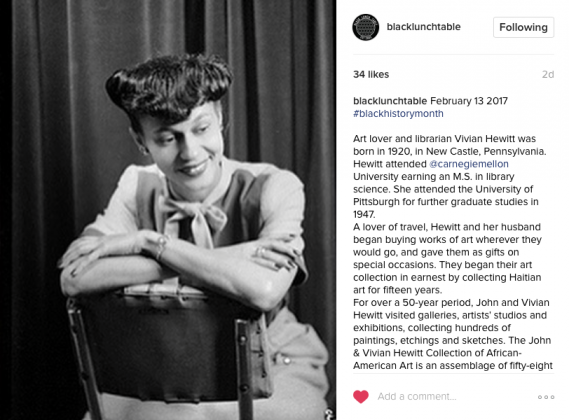The Black Lunch Table Helps Give Exposure to Black Artists Through Wikipedia

If you’ve ever wanted to learn more about an artist, chances are a Google search led you to their biography on Wikipedia. What happens if the artist you wanted to learn about isn’t on Wikipedia? Who is and isn’t on Wikipedia has more to do with gender and race than one might think. With this in mind, Heather Hart and Jina Valentine—working collectively as the Black Lunch Table—have launched an initiative through their practice to help black artists get on Wikipedia and fill in more of the details of their pages. It’s a seminal step in helping art history become more inclusive. On Feb 27, Creative Capital is hosting a Black Lunch Table Wikipedia Edit-A-Thon. You can RSVP here! We asked Heather some questions about the practice before the event.
Alex Teplitzky: Tell me about the Wikipedia edit-a-thons you’ve been hosting. What a great idea to help get artists online recognition!
Heather Hart: Yes! When Jina and I were in school, there was very little coverage of visual artists of the African Diaspora, especially notable contemporary people. Whether we like it or not, Wikipedia is used by 374 million unique visitors every month, more than your average encyclopedia has ever had. So this was a perfect fit for our over all Black Lunch Table project. We have the power to create a discursive site to fill gaps in the (art) historical record.
We spend time training participants about rules and tricks to make what they edit and add to Wikipedia stay there. The site is very vetted, and everything needs support and objective proof. We help people navigate that system so they can do it on their own. Then we provide a list of local artists that fit our scope who have little or no Wikipedia coverage for us all to focus on during that edit-a-thon. Volunteers help one-on-one, people have an impact and authorship of the records that generations will be accessing. That’s power.
Alex: What have been the outcomes of helping artists fill out their Wikipedia articles?
Heather: Well, first off, no artist is ever allowed to write their own page, nor anyone they are affiliated with. That would be ruled conflict-of-interest and immediately deleted by Wiki monitors.
But they can learn if they qualify for a page and edit someone else’s page while their page gets edited by a neutral party. We are currently building the tags to let us run reports about our metrics but I’d say that in a year we’ve had about 20 edit-a-thons all over the world and edited over 300 articles and created close to 30 new articles including one for Terry Adkins, Willie Birch, TJ Reddy, Shantrelle Lewis and Kambui Olujimi.
Alex: At the Creative Capital office, we’ve loved following your daily Black History Month posts on Instagram. You’ve already highlighted so many important individuals. Who have some of your favorites been so far?
Heather: Lady Bird Cleveland was photographed by Carl Van Vechten, she was a painter and she’s the mother of Pat Cleveland. She had a huge career in Harlem, and no one has documented her on Wiki yet!
Lloyd Yearwood is also one of my favorites. I met him while researching for a book and his archive of his work was insane and amazing. I can’t believe more people don’t know about him.
And Nettie Asberry. She is from the Northwest, like me, and was a huge activist for artists and women out there in the 19th century. Again, no Wiki article.
Man, and Vivian Hewitt! There are so many artists that wouldn’t have a career if it werent for her advocacy and collection! So much work to be done!
RSVP to Black Lunch Table’s Wikipedia Edit-a-Thon, happening Feb 27 from 6-9 here.

